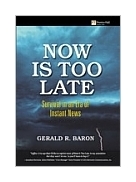|
||
• wydawnictwa polskie
• Zamów informacje o nowościach z wybranego tematu • kontakt
• Cookies na stronie |
NOW IS TOO LATEBARON Gwydawnictwo: PH , rok wydania 2003, wydanie Icena netto: It is a world of instant access, instant news, and-for-some-instant failure, if they don't understand the rules of this new post-media world. The internet, cable news, media and non-media is around the clock. Before you know it, your business could be maligned, your reputation defrocked, and all while you sleep. But it is not all bad. You can use these media and non-media too. Gerald Baron shows you how to protect your business and yourself, in this brave new world, and how to use the media and non-media as a tool for your own survival too. GERALD R. BARON is the
president and founder of Baron & Company, the leading full-service marketing and
public relations firm in Northwest Washington. Baron created the PIER System, the only
completely integrated Internet-based communication management system for crisis
communications, issue management, and ongoing press and public information management. Table of Contents Introduction 1. Discovering the New
World of Instant News. 2. Toward a Postmedia
World. 3. The New Audience. 4. How News Is Changing. 5. When Opponents Grab the Microphone. A Time of Cynicism. Media Infotainment. Activists and Other Opponents. Now They Have the Microphone. When the Politicians Get Involved. Endnotes. 6. How the Rules Have
Changed. 7. Communication
Strategies for the Instant News World. Audience: Whom Do We Need to Talk to? Message:
What Message Do We Need to Convey? Listening: What Do We Need to Hear From Them? Voice:
Who Needs to Deliver the Message? Media: How Should We Communicate? Endnotes. 9. The Role of
Technology. Information Development. Information Distribution. Interactivity and
Response. Inquiry Management. Web Site Control. Group Communication. Internal
Communication. User Access. Hosting. 12. Reputation Recovery: What To Do After It Happens. Getting out of the Bunker. Restoring Credibility. Returning to Normalcy. Endnotes. 13. A Glimpse Into the Future. Media Splintering. The Ubiquitous Internet. Wireless Connectivity. Replication of Experience. Everyone Is a Writer, Producer, Publisher, and Broadcaster. What It Means for Tomorrow's Communicators. Thinking Like a Broadcaster. Audience Control. The Battlefront of the Future: Being a Credible Source. Information Pointers. Truth Filters. The Sum of All Parts: Tell the Truth. Endnotes. Index 332 pages
Po otrzymaniu zamówienia poinformujemy, |


